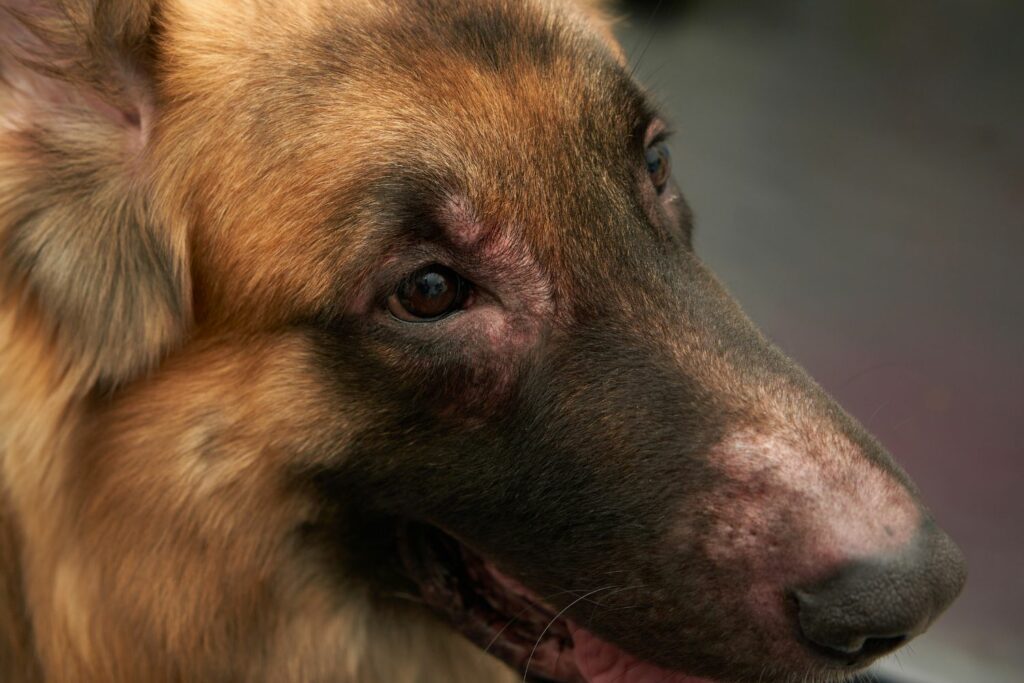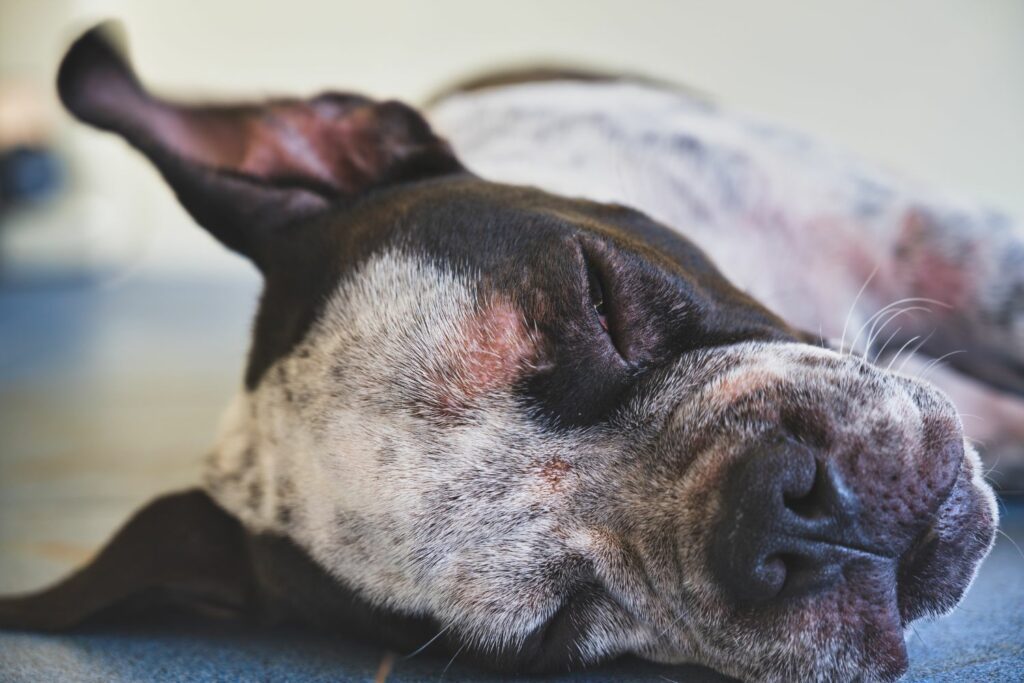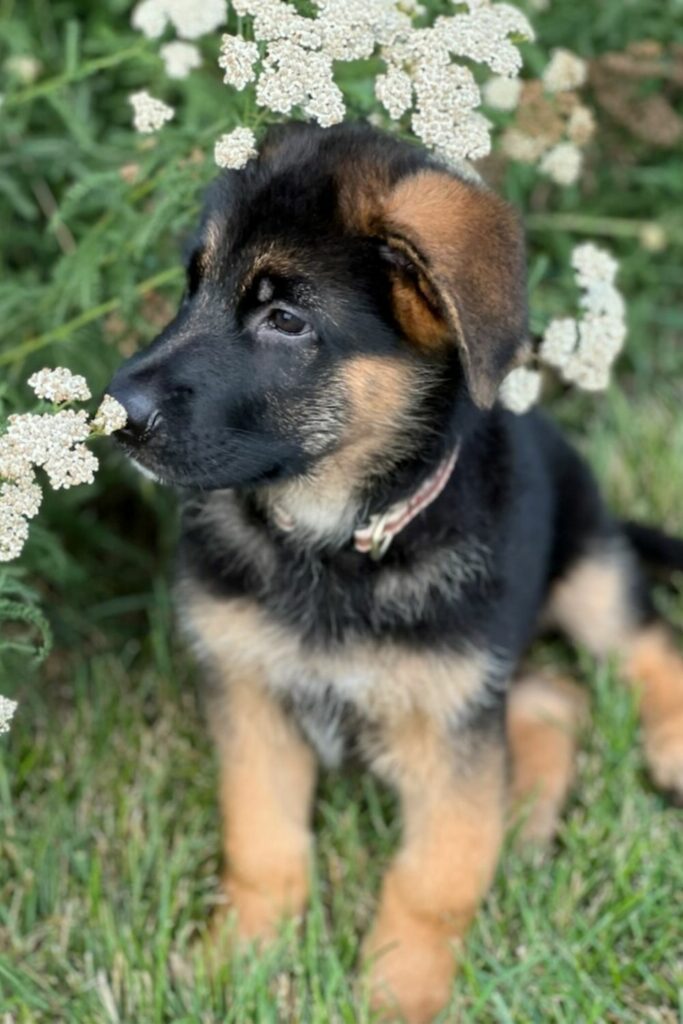Puppy Rash Treatment: Causes, Home Remedies & Prevention
 Synne Hemsen Berg
Synne Hemsen Berg
So, your lovely puppy dog has a rash and you’re stressed about what to do. Well, you’ve come to the right place – I’m going to shed some light to help you understand the cause (heat rash, food allergies, bacterial infections, stress, etc.) and how you can treat it and get your puppy itch-free.
Puppies are particularly prone to rashes as their immune system is still developing, they have more sensitive skin, and as they are curious, they more easily meet substances that irritate their skin. Rashes and itchy skin are relatively common in puppies, but adult dogs are also susceptible.

Moisturise the dog’s rash with an unscented ointment based on plant oils (coconut oil, for example, is excellent). If your puppy licks its paws a lot, you can also lubricate them. Ointments with calendula or aloe vera can be useful to try. You can also easily make paw cream at home with this recipe.
Now let’s discuss the cause of rashes, home treatment, preventive measures, and cover some frequently asked questions. Persistent, painful, and recurring rashes must be checked by a veterinarian.
What is a skin rash?
A rash is a noticeable change in the texture or colour of the skin. It can appear in various forms – spots, bumps, dryness, redness, or other abnormal conditions and discolourations – and may be localized to one area of the body or widespread. A dog’s rash can manifest in different ways, and the characteristics of a rash might include:
- Redness: Often, one of the most notable signs of a rash is red or inflamed skin.
- Itching: Rashes are frequently itchy, though this is not universal for all rash types.
- Swelling: The affected area may become swollen or puffy.
- Bumps or Pimples: Small raised bumps or spots, which may sometimes be filled with pus.
- Dry, Scaly, or Cracked Skin: Some rashes can cause the skin to become dry or scaly.
- Pain or Discomfort: Depending on the type, a rash may be painful or cause discomfort.
- Heat: The rash area might feel warm or hot to the touch.
- Altered Texture: Changes in the texture of the skin, becoming rough or smooth based on the underlying cause.

Specific types of rashes and conditions that may involve a rash:
- Dermatitis: General inflammation of the skin, which may appear as a rash.
- Eczema: A chronic condition characterized by dry, itchy rashes.
- Urticaria: Also known as hives, a rash characterized by raised, itchy welts on the skin.
- Psoriasis: A condition leading to red, itchy, and scaly patches of skin.
- Impetigo: A bacterial infection resulting in a blistering rash.
- Pruritus: Although this technically refers to itchiness, it’s often associated with various rash types.
- Erythema: Redness of the skin or mucous membranes, usually caused by inflammation or dilation of blood capillaries.
Common causes of rashes
1. Allergies and dermatitis
Your puppy may be allergic or sensitive to something in their environment or to something in their food. Symptoms include itching on the paws, groin, armpits and around the mouth/face. These symptoms usually appear around 6 months of age and before the dog is 2 years old. Common food allergy allergens include chicken, beef, eggs, soy, wheat and corn, while environmental allergens could be pollen and house dust mites.
2. Infections
Impetigo is a common bacterial infection, especially in puppies. Impetigo is characterized by red spots that develop into pimples/sores with a yellow, sticky crust. Often the dog will have a weaker immune system. Impetigo sores and skin infections in puppies are often found on the abdomen and groin. If your puppy shows signs of impetigo, you need to go to a vet as it is contagious and requires treatment. The treatment for their skin problems may include antibiotics and/or creams.

Wet eczema (hot spots) is also a troublesome skin rash and usually affects dogs with long, thick fur – and dogs that like to swim. Wet eczema is often moist, red, and irritated. It is intensely itchy and painful.
Puppies can also get fungal infections, such as ringworm. Fungal infections often lead to thickened skin in the area and may have a musty smell. Look for itchy and flaky skin that turns red. The vet will give the puppy antibiotics, and perhaps a cream or shampoo for fungal infections.
3. Stress rashes
Your puppy may react with stress to a new environment. Moving from the breeder to you is a transition, and it may take some time for it to settle into its new home – without mom, siblings, and the familiar surroundings of the breeder. It’s also a new microenvironment – with new bacteria and viruses. The puppy may then have a temporary period with a slightly loose stomach, and possibly a rash.

You can try to relieve stress with some soothing chamomile tea. Make a small cup of chamomile tea (fill the cup halfway) and let it steep for 5 minutes. When it’s lukewarm, pour it over your puppy’s food. Chamomile is an herb that is safe for dogs and has a mildly calming effect.
4. Skin irritation from external parasites
Parasites that bite and irritate the puppy’s skin can cause a rash. Your puppy may also have an allergic reaction to parasites. Additionally, insect bites can lead to an infection such as impetigo, fungi, viruses. It is easy to see if your dog has a parasite as you will be able to spot fleas, lice or ticks sitting on the hair or skin. If you spot external parasites on your dog, you should contact your vet to get the correct treatment.
5. Genetics/atopic disposition
Some dog breeds are more prone to allergies than others. If your dog has an atopic disposition, it is a lifelong condition that needs to be managed. You will have to work with your veterinarian to plan the optimal long-term treatment for your dog.

6. Hormonal imbalance
A hormonal imbalance in the body such as hypothyroidism or Cushing’s disease can also lead to dog rash. Hormonal imbalance can contribute to hair loss, fatigue, weight fluctuations, frequent urination, and ear infections. Rashes caused by hormonal imbalances must be treated by a veterinarian. This usually affects older dogs.
Home remedies for puppies with a rash
Always seek help from a veterinarian before starting home treatment to determine the cause of the rash and get medication if necessary. Remember that your puppy’s skin is sensitive, so be gentle.
1. Soothe red and irritated skin
Apply cold chamomile tea to the rash. Make a large cup of chamomile tea and chill it. Apply the cooled chamomile tea to the rash. Chamomile is soothing (especially when cold) and mildly antiseptic.
Give your dog an oat bath. Fill a bathtub with lukewarm water and ground oatmeal. Give your dog a bath in this water. Optionally, you can use a clean, wet cloth dipped in the oat water to wash your dog with it.

The skin’s pH value is important for its resilience. A vinegar wash can help bring the skin’s pH back to normal. Use a clean cloth and wash over your dog’s fur with a mixture of one part apple cider vinegar to four parts water. This helps to lower the pH value of the skin. NB! Avoid if the skin has cracks or open wounds because it stings intensely.
Investing in a humidifier may be a good idea if you have a very dry indoor climate. In general, regular ventilation is important for a healthy indoor climate.
2. Diet and supplements for rashes
Give supplements that are beneficial for maintaining the skin barrier such as omega 3, zinc, and vitamin C. You can also make some flaxseed meal, which is rich in fibre and ALA/vegetable omega 3. You can make the meal with a blender. Stir 2 tablespoons of flaxseed meal into their food with a little water. This also regulates the intestines and has a mild laxative effect, so do not give too much. You can give this to your puppy a couple of times a week. Feeding a high-quality food that contains beneficial nutrients for skin health, such as Nala Health, can help.

Preventing Rashes in Puppies
- Proactive Parasite Control: Use regular flea and tick preventatives to protect your puppy from parasitic infections.
- Hypoallergenic Diet: Adopt a diet that minimizes the risk of allergic reactions.
- Regular Grooming: Ensure consistent grooming to keep their skin clean and to identify potential issues early.
- Safe Environment: Create a puppy-proof environment, minimizing exposure to potential irritants and allergens.
Frequently Asked Questions
- Q1: Can I use human anti-itch creams on my puppy? Not all human medications are safe for pets. Always consult a veterinarian before applying any human-grade products to avoid potential toxicity.
- Q2: How can I identify what’s causing the rash on my puppy’s skin? Identifying the exact cause can be challenging and might require a veterinarian’s expertise through examinations and possible allergy testing.
- Q3: Can a puppy get a rash from stress? Yes, stress can manifest in physical symptoms, including rashes. Stress-induced dermatitis can result from significant changes in environment or routine.
- Q4: How long does it take for a puppy rash to heal? The healing duration may vary based on the cause and severity. Mild rashes may dissipate within a few days with appropriate care, while others might require prolonged treatment.

Recognizing and understanding the potential causes of your dog’s skin rashes, while incorporating viable home treatments and preventive measures will give you the best chance to enhance the quality of life for your fur baby.
However, always remember that the advice and guidance of a veterinarian are indispensable when it comes to managing your puppy’s health.

